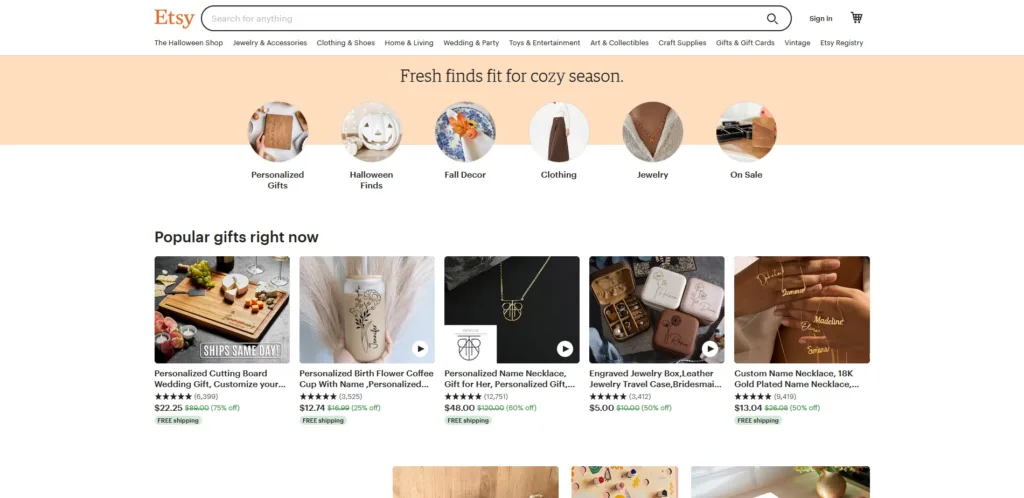If you’re a creative, entrepreneurial woman looking for a new opportunity to monetize your skills, selling on Etsy might just be the perfect fit for you. With over 2 million active sellers, Etsy has become a popular platform for artists, crafters, and makers to showcase and sell their unique products.
As someone who currently runs two successful Etsy shops and has gone through the good, the bad, and the ugly of using the platform, I’m here to share my tips and tricks for turning your passion into a profitable business. I’ll also share a specific link with you that allows you to start with 40 free listings (you could save up to $8 in fees!). Keep in mind, however, that in 2024 Etsy has implemented a $15 setup fee to simply open a shop, so it’s no longer entirely free to get started. This is to verify that you’re a real seller and allows the platform to stay safe from fraudulent people.
We’ll talk about each step of the way, from researching your market and choosing a niche, to creating your account, to utilizing marketing strategies and tracking your sales. You’ll have the tools and insights you need to turn your Etsy shop into a thriving business, so let’s get started!
1. Research The Market

Before launching your Etsy shop, it’s essential to research the market to ensure your products will be in demand and profitable. Here are a few key steps to take:
- Identify popular products and their demand on Etsy: Take some time to browse the platform and see what types of products are selling well. Pay attention to the product categories, materials, and styles that seem to be in high demand. Utilize Etsy’s search bar and filters to view the most popular items in different categories. Consider using keywords related to your products to see what comes up in search results. This information can help you make informed decisions about the types of products you want to offer.
- Analyze competition and pricing strategies: Once you have a good understanding of the products that are in demand, take a closer look at your competition. Analyze their pricing strategies and what makes their products unique. Look at their product descriptions, photographs, and feedback to get an idea of how they present their offerings. Use this information to determine your own pricing strategy and to ensure that your products stand out in a crowded market. Consider big sales taking place at specific times of the year, plus minor sales every so often, where your lowered prices would still have to make you enough profit from your sold items during these sales.
- Decide on niche and target market: Finally, choose a niche and target market for your shop. A well-defined niche will help you focus your efforts and reach your ideal customers. Consider factors like demographics, interests, and buying habits to identify your target market. Research the average income, age range, and location of your ideal customers to get a better understanding of their needs and preferences.
By conducting thorough market research, you’ll be well-equipped to create a successful Etsy shop that appeals to your target customers and stands out from the competition.
Ready to finally create your account and list your first product?
2. Open an Etsy Account – Step By Step

Setting up an Etsy account is simple and straightforward, and this tutorial will guide you through the process step-by-step.
Understanding Etsy Fees
As a new seller, you’ll encounter various fees that impact your profitability.
- Setup Fee: Opening an Etsy account used to be entirely free, but as of 2024, they’ve implemented a $15 fee to get started. This fee helps maintain the integrity of the platform by keeping it secure from fraudulent sellers.
- Listing Fees: Each listing you create on Etsy incurs a $0.20 fee. Listings expire after four months, and you’ll be charged another $0.20 to renew each listing that hasn’t sold. However, you can use my referral link, and get your first 40 product listings for free. Once you’re on your seller dashboard, if you click on the “Listings” tab, you’ll be able to see how many free listings you have left. Consider setting your listings to manual renewal, so you can decide whether to renew them after evaluating their performance.
- Relisting Fees: Once a listing sells, Etsy automatically relists it for you, charging an additional $0.20. This fee is applicable each time an item is sold and relisted.
- Transaction and Processing Fees: For each sale, Etsy charges a 6.5% transaction fee. Additionally, a 3% processing fee may apply, depending on the payment method used by the buyer.
Creating Your Seller Account
Step 1: Click on this link right here to open an Etsy account that includes 40 free listings from the get-go. You’ll see a message with my name and my picture inviting you to “Open a shop today”, so click on that to register. Make sure you see this message before continuing, as I’ve once made the mistake of creating an account as a buyer first, and later when I wanted to open a shop, I was unable to use a referral link and get the free listings for myself. (Note that by opening an account with my link, I’ll get 40 free listings as well added to my shop, at no extra cost to you, so we’re both helping each other here).
Step 2: In the registration form, enter your email address in the first field. Make sure the email address you provide is valid and accessible as this will be used for communication from Etsy. It’s also important that this is an email address that you’ve never used on Etsy before, even simply as a customer.
Step 3: Create a secure password for your Etsy account in the next field. Ensure the password you choose is strong and easy to remember.
Step 4: In the form, provide your first name, last name, and address. This information will be used for billing purposes and to help verify your identity.
Step 5: Once you have entered all the required information, click on the “Register” button.
Step 6: Etsy will send a confirmation email to the email address you provided in step 2. Check your email inbox and click on the “Confirm Email Address” button in the email from Etsy.
Step 7: Once you have confirmed your email address, log in to your Etsy account. Complete your profile by providing additional information, such as your location, shop language, and profile picture.
Step 8: Before you can open your shop, you need to create your first listing. On your Etsy dashboard, click on the “Listings” tab and then “Add a Listing.” Follow the prompts to create your first listing, including adding product descriptions, images, and pricing. (Don’t worry too much about this first listing being perfect, you can always edit it later, and it’s highly unlikely that anyone will find it within the first few hours. So just make sure you create a simple listing and then everything else -pictures, description- can be edited later when you’re ready).
Step 9: Once you have created your first listing, you are ready to set up your shop. On your Etsy dashboard, click on the “Open Your Etsy Shop” button and follow the steps to set up your shop. You will be asked to provide information about your shop, such as its name, the products you want to sell, and your payment and shipping methods. And that’s it! Your Etsy account is now set up, and you are ready to start selling on Etsy.
3. Important Considerations
Legal Requirements for Selling on Etsy
A common question for new Etsy sellers is whether they need to establish a legal business entity, like an LLC or sole proprietorship. The good news is that you don’t need any specific legal registration to start selling on Etsy. However, it’s recommended to have some official documentation for your business, such as registering as a sole proprietorship with your local government, to protect yourself legally.
Setting Up Shop Terms, Conditions, and GDPR Compliance
You have to establish clear terms and conditions, including privacy policies, especially if you plan to sell internationally. Compliance with GDPR (General Data Protection Regulation) is required when dealing with customers in the European Union. This involves creating a statement that outlines how you protect user data.
Tools, Apps, and Integrations for Etsy Success
One of the exciting aspects of selling on Etsy is the wide range of tools, apps, and integrations available to streamline your business. For example:
- Printify: As a print-on-demand seller, I use Printify to handle production and shipping, making it easier to manage orders without holding inventory.
- Hello Custom: This tool assists with product personalization and scaling your business without requiring a large team.
- Everbee: A market research tool that helps you identify trending products, optimize your listings, and grow your email list through QR codes and other features.
There are countless other integrations available, such as QuickBooks for accounting or Pinterest for social media marketing, all designed to make running your Etsy shop more efficient.
Beware of Etsy Scams
Scams are an unfortunate reality on Etsy, especially for new sellers. Be cautious of fraudulent accounts posing as businesses or customers trying to steal personal information like your Social Security number or bank details. Never click on suspicious links or share sensitive information with unknown parties. Staying vigilant can protect you from potential fraud.
I myself have received a private message shortly after creating my account. They claimed to be an Etsy employee (even using Etsy’s logo as their profile picture) requesting personal information to verify my account. Because I’d already been warned about this happening, I was able to quickly dismiss the message and report it as spam.
Prohibited Items on Etsy
Etsy has a list of prohibited items that sellers are not allowed to list on the platform. Some of these restrictions may surprise you:
- Children’s Hoodies with Strings: These items have been banned due to potential choking hazards.
- Amber Jewelry: Items containing amber, especially for children, have been flagged as hazardous and are not allowed on Etsy.
- Firearms and Related Products: Anything related to guns or gun violence is strictly prohibited.
Make sure to familiarize yourself with Etsy’s prohibited items list to avoid having your listings removed or facing other penalties.
Avoiding Infringement
Trademark infringement is a serious issue on Etsy, and it’s something all sellers need to be aware of. Many sellers unknowingly violate trademarks by listing items that feature characters, logos, or brands from popular movies, TV shows, or books without permission. This can lead to your listings being taken down or even legal action from the trademark owners.
So, you’ve noticed other sellers getting away with trademarked items and assume nothing will happen if you do the same? The reason this occurs is that companies must report infringing listings individually, and Etsy cannot automatically remove them without the company’s involvement. This means there’s no way to predict when your listing—or even your entire account—could be taken down. However, it’s still illegal and a risk that’s simply not worth taking.
To avoid this, regularly check your listings for any potential infringements. Tools like Everbee offer a trademark monitor system that can help you identify and remove any problematic content from your shop.
4. Develop a Strong Brand and Online Presence
Now that you’ve opened your shop, having a strong brand and online presence is crucial to its success. Here are some tips to help you create a professional and memorable brand that will attract customers:
- Create a consistent brand identity: Develop a consistent visual brand identity that accurately reflects your products and appeals to your target market. This includes creating a memorable logo, color scheme, and font style that will be used across all your marketing materials.
- Optimize your shop’s appearance: Make sure your Etsy shop is visually appealing and easy to navigate. Invest in high-quality product photographs that showcase your products in a visually appealing way. Ensure that your shop’s homepage, about page, and listings are well-designed and provide a clear and concise description of your products. You can use Canva to create a beautiful banner for your shop (Etsy banners look great at exactly 2400×600, as opposed to the recommended size which actually makes them look blurry).
- Utilize social media: Utilize social media platforms like Instagram and TikTok to promote your products and engage with your audience. Share behind-the-scenes looks at your creative process, offer sneak peeks of new products, and interact with your followers. Utilize hashtags and collaborate with like-minded brands and businesses to expand your reach, and consider running social media contests or giveaways to increase engagement.
- Build a website: Consider building a website for your shop in addition to your Etsy presence. This will give you more control over your online presence and allow you to reach a wider audience. Of course, this is nothing to stress over when you’re just opening your shop, but it’s something to keep in mind for the future.
5. Offer Unique, High-Quality Products

In order to be successful on Etsy, it’s essential to offer unique, high-quality products that your customers will love. Here are some tips to keep in mind:
- Focus on quality over quantity: Rather than trying to offer a large variety of products, focus on a smaller selection of high-quality offerings. Take the time to create well-crafted, unique products that stand out from the competition. Quality over quantity can lead to better customer reviews, repeat customers, and a strong reputation.
- Use high-quality materials: Invest in high-quality materials that will make your products look and feel professional. This can include anything from premium fabrics and paints to specialized tools and equipment. Using top-notch materials can increase the perceived value of your products and lead to more satisfied customers.
- Offer customization options: Consider offering customization options for your products to give customers a personalized touch. This can be as simple as offering different color options or as complex as customizing the product to their specific needs. Customization options can differentiate your products from others on Etsy and lead to repeat customers.
- Pay attention to packaging and presentation: Don’t underestimate the impact of good packaging and presentation. Make sure your products are packaged in a way that protects them during shipping and also enhances their presentation when they arrive at the customer’s door. Beautiful packaging can lead to better unboxing experiences and positive reviews for your products.
- Constantly improve and innovate: Strive to constantly improve and innovate your product offerings. Keep an eye on market trends, gather feedback from customers, and experiment with new materials, techniques, and product designs. This will keep your shop fresh and relevant and attract repeat customers.
By focusing on unique, high-quality products, you’ll set yourself apart from the competition and give customers a reason to choose your shop over others. Additionally, customers are more likely to leave positive feedback and refer your shop to others if they are pleased with their purchases.
6. Optimize Shipping and Handling

Shipping and handling can have a big impact on customer satisfaction, so it’s important to optimize this aspect of your Etsy shop. Here are some tips to keep in mind:
- Offer free shipping or low-cost shipping options: Consider offering free shipping or low-cost shipping options to attract more customers to your shop. You can absorb the cost of shipping into the product price or offer it as a promotional incentive. Free shipping can also help reduce shopping cart abandonment, as shipping fees are often a major concern for customers. (Here’s a secret: people will always choose what they perceive as a bigger deal, as in, they’ll rather buy a $20 product that offers free shipping, than a $15 product + $5 shipping. They’ll consider a higher-priced product to be of higher quality, when in reality both listings may be the exact same product, only that the seller of the $20 one decided to include the shipping within the product price and label it as “free shipping”).
- Make shipping options clear and easy to understand: Make sure your shipping options are clearly explained on your product listings and at checkout. Use clear, concise language and provide estimated delivery times so customers know what to expect. Also, consider providing tracking information for each order so customers can easily track the progress of their shipment.
- Invest in quality packaging materials: Invest in high-quality packaging materials to protect your products during shipping and ensure that they arrive in good condition. This can include bubble wrap, shipping boxes, and filler materials. You should also make sure that the packaging is aesthetically pleasing and reflects your brand. A beautifully packaged product can create a positive impression and increase customer satisfaction. You could also add a Thank You card with your shop info and maybe even a discount for a next purchase. Customers would appreciate the extra detail and that would incentivate them to give your product a positive review.
- Offer international shipping: Consider offering international shipping to reach a wider customer base. Make sure to research customs and taxes for international shipping, and clearly explain your international shipping policies on your product listings. Be aware of any restrictions or prohibited items for international shipping, and make sure to comply with all regulations.
- Partner with a reliable shipping carrier: Partner with a reliable shipping carrier that provides fast, efficient, and affordable shipping services. Consider offering multiple shipping options, such as standard, expedited, and overnight shipping, so customers can choose the option that best meets their needs.
By optimizing your shipping and handling process, you can ensure a smooth and satisfying experience for your customers. This can lead to positive reviews, repeat customers, and increased sales for your Etsy shop.
7. Utilize Marketing and Sales Strategies
Marketing and sales strategies can help you reach a wider audience and increase sales for your Etsy shop. Here are some tips to keep in mind:
- Offer promotions and sales: Consider offering promotions and sales, such as limited-time discounts or buy-one-get-one-free deals, to encourage customers to make a purchase. This can also help clear out slow-moving inventory and drive sales during slow periods. You can also offer coupon codes for first-time customers or for special promotions.
- Build an email list: Build an email list by offering exclusive deals and promotions to subscribers. Use your email list to keep customers informed of new product releases, restocks, and other important updates. You can also send out newsletters to share your brand story and showcase your products.
- Collaborate with influencers and bloggers: Consider collaborating with influencers and bloggers in your niche to reach a wider audience. You can offer product samples or compensation in exchange for a review or feature on their platform. When selecting influencers or bloggers, look for those with a following that aligns with your target audience. Also, be sure to set clear expectations and guidelines for the collaboration to ensure a positive outcome for both parties.
- Utilize keywords and tags: Utilize keywords and tags in your product listings to improve search engine optimization (SEO) and make it easier for potential customers to find your shop. Optimize your product titles and descriptions with keywords, but be sure to avoid keyword stuffing as this can negatively impact your SEO.
Stay creative, stay focused, and remember that marketing and sales are ongoing processes that require consistent effort.
8. Monitor Sales and Analytics

Regular monitoring of your sales and analytics is a critical part of running a successful Etsy shop. Here are some tips for making the most of your metrics:
- Set goals: Set specific, measurable goals for your Etsy shop, such as increasing sales volume or improving conversion rate. Use your metrics to track progress towards these goals and make changes as needed.
- Use analytics tools: Make use of Etsy’s built-in analytics or Google Analytics, to track your metrics and gain insights into your shop’s performance. These tools can help you identify trends and patterns in your data, allowing you to make informed decisions about your business.
- Compare to industry averages: Compare your metrics to industry averages to see how your shop is performing in comparison to others. This can help you identify areas for improvement and set realistic goals for your shop.
- Regularly review your metrics: Make it a habit to regularly review your metrics, such as once a week or once a month. This will help you identify any changes in your shop’s performance and make adjustments as needed.
- Take action based on your data: Use the insights from your metrics to make informed decisions about your Etsy shop. For example, if you see that a particular product is not selling well, you may choose to discontinue it or make changes to improve its performance.
Running an Etsy shop requires effort and dedication, and I know that it can get very overwhelming at the beginning. This is a long guide and you may think there’s too much to focus on, but if you take one step at the time and gain experience from each, you’ll soon become an expert and all this will become second nature to you. All you have to do right now is create an account and list your first item. Just remember that success on Etsy takes time and patience, and it is important to constantly evaluate and adjust your strategies based on the performance of your shop. With hard work, determination, and commitment, you can turn your Etsy shop into a thriving business.




